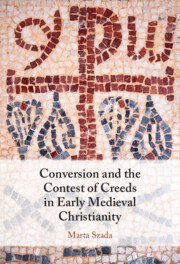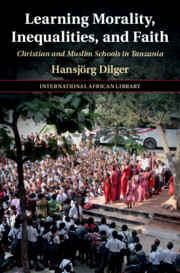Refine search
Actions for selected content:
26 results
Chapter 21 - Culturally responsive pedagogy: Respecting the diversity of learners studying HASS
- from Part V - HASS for all learners
-
-
- Book:
- Making Humanities and Social Sciences Come Alive
- Published online:
- 02 August 2025
- Print publication:
- 14 August 2025, pp 355-376
-
- Chapter
- Export citation
Sacred politics of Chinese infrastructure: Christians, Buddha’s tooth, dragons, and conflict at Myitsone, Kachin, Burma
-
- Journal:
- Modern Asian Studies / Volume 58 / Issue 5 / September 2024
- Published online by Cambridge University Press:
- 09 June 2025, pp. 1379-1406
- Print publication:
- September 2024
-
- Article
-
- You have access
- Open access
- HTML
- Export citation
Conclusion
-
- Book:
- Conversion and the Contest of Creeds in Early Medieval Christianity
- Published online:
- 06 June 2024
- Print publication:
- 13 June 2024, pp 284-294
-
- Chapter
- Export citation

Conversion and the Contest of Creeds in Early Medieval Christianity
-
- Published online:
- 06 June 2024
- Print publication:
- 13 June 2024
The unreality of traditional Islamic theism's views on belief, providence, and eschatology: a rejoinder to Tabur
-
- Journal:
- Religious Studies , First View
- Published online by Cambridge University Press:
- 22 April 2024, pp. 1-21
-
- Article
-
- You have access
- Open access
- HTML
- Export citation

God in Moral Experience
- Values and Duties Personified
-
- Published online:
- 09 November 2023
- Print publication:
- 23 November 2023
Counting hiddenness: cognitive science and the distribution of belief in God
-
- Journal:
- Religious Studies / Volume 61 / Issue 3 / September 2025
- Published online by Cambridge University Press:
- 06 October 2023, pp. 615-633
- Print publication:
- September 2025
-
- Article
-
- You have access
- Open access
- HTML
- Export citation
27 - Migrant Clerics Going East and West
- from Part IX - Religious Migration
-
-
- Book:
- The Cambridge History of Global Migrations
- Published online:
- 12 May 2023
- Print publication:
- 01 June 2023, pp 526-546
-
- Chapter
- Export citation
Chapter 5 - The Spiritual Turn
- from Part III - The Spiritual Turn
-
- Book:
- God, the Good, and the Spiritual Turn in Epistemology
- Published online:
- 19 August 2022
- Print publication:
- 18 August 2022, pp 121-167
-
- Chapter
- Export citation
C'est juste une blague ! Vraiment ? Quand l'humour et la religion alimentent les stéréotypes
-
- Journal:
- Canadian Journal of Political Science/Revue canadienne de science politique / Volume 55 / Issue 3 / September 2022
- Published online by Cambridge University Press:
- 19 May 2022, pp. 619-644
-
- Article
-
- You have access
- Open access
- HTML
- Export citation

Learning Morality, Inequalities, and Faith
- Christian and Muslim Schools in Tanzania
-
- Published online:
- 16 December 2021
- Print publication:
- 16 December 2021
Chapter 2 - Religious Truth and Pluralism from a Pragmatist Point of View
-
- Book:
- Pragmatist Truth in the Post-Truth Age
- Published online:
- 14 September 2021
- Print publication:
- 23 September 2021, pp 40-68
-
- Chapter
- Export citation
God de re et de dicto: Kierkegaard, faith and religious diversity
-
- Journal:
- Scottish Journal of Theology / Volume 74 / Issue 2 / May 2021
- Published online by Cambridge University Press:
- 26 May 2021, pp. 135-146
- Print publication:
- May 2021
-
- Article
- Export citation
The difference a wire makes: planning law, public Orthodox Judaism and urban space in Australia
-
- Journal:
- International Journal of Law in Context / Volume 16 / Issue 4 / December 2020
- Published online by Cambridge University Press:
- 12 January 2021, pp. 403-421
-
- Article
- Export citation
Introduction
-
- Book:
- Islam in a Zongo
- Published online:
- 08 January 2021
- Print publication:
- 07 January 2021, pp 1-31
-
- Chapter
- Export citation
1 - Christian Political Theology as Comparative Theology
-
- Book:
- Law and the Rule of God
- Published online:
- 28 October 2020
- Print publication:
- 05 November 2020, pp 1-47
-
- Chapter
- Export citation
3 - Theology, Religious Diversity, and Religious Experience
- from Part I - Characterizing Religious Experience
-
-
- Book:
- The Cambridge Companion to Religious Experience
- Published online:
- 20 June 2020
- Print publication:
- 16 July 2020, pp 76-96
-
- Chapter
- Export citation
8 - Religious Experience Cognized
-
- Book:
- Understanding Religious Experience
- Published online:
- 21 November 2019
- Print publication:
- 05 December 2019, pp 283-334
-
- Chapter
- Export citation
A Tale of Two (Diverse) Countries: Religious Diversity in Canada and Singapore
-
- Journal:
- German Law Journal / Volume 20 / Issue 7 / October 2019
- Published online by Cambridge University Press:
- 30 October 2019, pp. 986-1006
-
- Article
-
- You have access
- Open access
- HTML
- Export citation
Religious Education in Germany in Light of Religious Diversity: Constitutional Requirements for Religious Education
-
- Journal:
- German Law Journal / Volume 20 / Issue 7 / October 2019
- Published online by Cambridge University Press:
- 30 October 2019, pp. 1047-1065
-
- Article
-
- You have access
- Open access
- HTML
- Export citation
